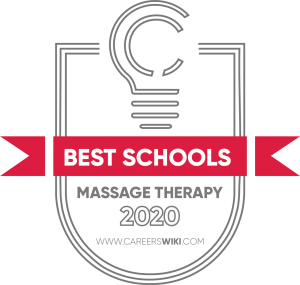…
There are 23 massage therapy schools in Iowa that authorities have approved. They are scattered across the state, in cities and small towns.
The education programs combine classes with labs, as well as practical experience in student clinics or private facilities. Graduates receive certificates within about a year. Some schools offer bachelor’s degree programs, which generally take two years to complete.
The employment prospects for practitioners in the Hawkeye State are slightly better than the national average (view massage schools in other states). Officials expect 160 annual job openings during the decade ending in 2026.

This regulatory agency “promotes the health, welfare, and safety” of massage therapy in the state. It assesses the qualifications of license applicants, approving those who have received the mandated education and passed a licensure exam.
The board establishes rules and regulations “to ensure the integrity and competence” of practitioners. It investigates complaints of alleged unprofessional conduct, and takes disciplinary action when warranted.
There are seven panel members, four of whom hold massage therapy licenses. The other three represent the public. The governor appoints all members, with state Senate approval. Board terms are three years, with no one serving more than three terms.
Postsecondary schools accept only students who have graduated from high school or obtained GEDs. To become a massage therapist in Iowa, it is necessary to successfully complete an education program at an accredited institution that the state board has approved.
Iowa requires curricula to consist of at least 600 clock hours. Core courses must cover massage therapy fundamentals, anatomy and physiology, massage and bodywork clinical application, kinesiology, pathology, client communications, healthcare referral, business management, and laws and ethics. The 600 hours are to include 120 hours of clinical work.
Upon graduation, the next step is applying online to the state board for licensure. This entails a fee of about $120. Qualified applicants then contact the Federation of State Massage Therapy Boards to seek approval to take the Massage and Bodywork Licensing Examination (MBLEx). Students schedule their exam sessions at Pearson VUE testing centers in Davenport, Sioux City, Coralville, West Des Moines, or Sioux Falls.
The exam, which students must finish within two hours, features 100 multiple-choice questions concerning client assessment, treatment plans, benefits and physiological effects of massage techniques, pathology with contraindications, treatment for special populations, ethics, laws and regulations, guidelines for professional practice, kinesiology, and anatomy and physiology.
Students who pass the MBLEx are eligible for licensure, if they have CPR and first aid certification. Licenses must be renewed every two years, which involves 24 hours of continuing education units. Half of the hours must be accrued in “hands-on training.”
We selected the schools below based on the programs that they offer, accreditation, student population, graduation rate and reputation.
View our Ranking Methodology to learn more about how we rank schools.

56%
45
Located in the suburb of Urbandale, ISB provides a 650-hour certificate program that takes 14 months to complete. Students attend daytime classes 25 or more hours per week.
Courses cover deep tissue, sports, prenatal/infant, geriatric, rehabilitation, corporate, and hot stone massage. Students also learn about trigger-point therapy, aromatherapy, and therapeutic body wraps.
The school furnishes a student kit with all the necessary equipment, including a massage table; as well as four textbooks and supplies.
95%
45
This school’s beautiful rural campus is in Stone City, near Cedar Rapids. It is the oldest institution of its kind in Iowa.
The 775-hour program takes full-time students six months, and part-timers 11.5 months, to finish. It teaches these massage techniques: Swedish, deep tissue, sports, chair,, pregnant/side-lying, myofascial, hot stone, and lymphatic. Students also take classes in hydrotherapy, aromatherapy, acupressure, pin and stretch, herbology, and craniosacral therapy. The school’s student clinic provides real-world experience.
More than 95 percent of program participants graduate, and all of them usually pass the MBLEx licensure test.
67%
95
In operation since 1978, this school has a 600-hour program that includes 120 hours of anatomy and physiology.
Among the courses are Swedish Massage, Seated Chair, Deep Tissue, Pregnancy Massage, Infant Massage, Trigger Point Therapy, Myofascial Release, Athletic & Sports Massage, Lymphatic Drainage, Craniosacral, and Wellness & Heated Stone Therapy. There is also a 120-hour clinical practicum.
The school provides iPads, kits, and books; reimburses students for the license exam fee; and offers free continuing education to alumni. Students benefit from individual coaching and nationwide job-placement assistance.
60%
440
This is a family-owned business founded in 1966. It has campuses in Cedar Rapids, Davenport, Waterloo, and Dubuque.
The 720-hour massage therapy program can be completed in 30 weeks by attending school 28 hours per week. Students learn Swedish, deep tissue, Thai, prenatal, infant, sports, and hot stone massage techniques. They also study aromatherapy and spa treatments, and give massages to the public in a student clinic.
Tuition covers CPR training and certification, as well as license exam fees. The school pays for linens and laundry facilities, iPads, textbooks, uniforms, and massage table that students keep.
81%
138
This is one of more than 60 Aveda campuses in the United States. The institute bills itself as “the number one beauty school in the country.” It describes the Des Moines site as “ Iowa’s award-winning, cutting edge, eco-friendly cosmetology and spa Institution.”
The 750-hour massage therapy program involves 25 weeks of classes on Tuesdays, Thursdays, and Saturdays. Students learn Swedish, deep tissue, and lymphatic/pregnancy massage. They also take classes in aromaology, hydrotherapy, trigger points, acupressure, polarity, and chakra balance.
In addition to getting hands-on clinical experience, students tour spas, chiropractic facilities, and medical practices.
63%
315
This beauty school, established nearly a half-century ago, has campuses in Cedar Falls, Fort Dodge, Iowa City, Davenport, and Johnston. LJIC’s site in Mason City is called the College of Hairstyling and Cosmetology.
The 900-hour massage therapy certificate program includes a 180-hour clinical practicum. Students learn to administer massage methods such as Swedish, chair, sports, stone, prenatal, and deep tissue.
The school also offers a two-year Associate of Applied Science degree in health and beauty management that can be completed in one year. Graduates are certified in massage therapy and esthetics.
54%
2011
This small public school is in Spenser, a northern Iowa town with a population of about 11,000 people.
The massage therapy program consists of 739.2 contact hours and 39 credits. In addition to the typical coursework, classes include Introduction to Swedish Massage, Sports Massage, Spa Bodywork I and II, Geriatrics Massage, Intermediate Massage, Pregnancy/Infant Massage, Chair Massage, and Deep Tissue Massage.
The curriculum also features clinical rotations at area massage facilities.
33%
4090
Based in Ottumwa, IHCC primarily serves students from a 10-county area in southwest Iowa and from northern Missouri.
The 1,000-hour massage therapy program takes 12 months to complete. Along with the usual required courses are Computer Essentials, Medical Terminology, Pathophysiology, and Topics in Therapeutic Massage. Students take part in a pair of 100-hour clinical practicums at long-term care facilities, massage practices, spas, or hospitals.
The curriculum includes general education courses, which are available on the Ottumwa and Centerville campuses as well as at IHCC service centers.
$18
$38,000
28%
The average Iowa practitioner makes an annual salary of about $38,200 (or an hourly wage of nearly $18.50), a bit less than the national median of almost $41,500 a year (or about $20 per hour).
The top 10 percent of earners receive more than $65,200 (or about $31.50) in the state, compared with around $78,300 (or more than $37.50) nationally. For the bottom 10 percent, the pay is about $19,500 (or nearly $9.50) in Iowa; and over $21,300 (or about $10.25) nationwide.
There were 1,100 licensed massage therapists in this state in 2016, according to the U.S. Bureau of Labor Statistics. The agency predicts that the number will increase to 1,410 by 2026. That would be a job-growth rate of 28 percent, faster than the projected national median of 26 percent.
Sources: U.S. Bureau of Labor Statistics, CareerOneStop

LIMITED TIME DEAL